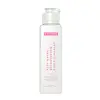What's inside
What's inside
 Key Ingredients
Key Ingredients

 Benefits
Benefits

 Concerns
Concerns

 Ingredients Side-by-side
Ingredients Side-by-side

Water
Skin ConditioningCocamidopropyl Betaine
CleansingAcrylates Copolymer
Coco-Glucoside
CleansingSodium Cocoyl Glycinate
CleansingGlycerin
HumectantNiacinamide
SmoothingTriethanolamine
BufferingRice Ferment Filtrate
Skin ConditioningOryza Sativa Extract
AbsorbentCapryloyl/Caproyl Methyl Glucamide
EmulsifyingLauroyl/Myristoyl Methyl Glucamide
EmollientPhenoxyethanol
PreservativeEthylhexylglycerin
Skin ConditioningOlive Oil PEG-7 Esters
EmollientStyrene/Acrylates Copolymer
Disodium EDTA
Sodium Hyaluronate
HumectantParfum
MaskingPanthenol
Skin ConditioningButylene Glycol
HumectantTocopheryl Acetate
AntioxidantWater, Cocamidopropyl Betaine, Acrylates Copolymer, Coco-Glucoside, Sodium Cocoyl Glycinate, Glycerin, Niacinamide, Triethanolamine, Rice Ferment Filtrate, Oryza Sativa Extract, Capryloyl/Caproyl Methyl Glucamide, Lauroyl/Myristoyl Methyl Glucamide, Phenoxyethanol, Ethylhexylglycerin, Olive Oil PEG-7 Esters, Styrene/Acrylates Copolymer, Disodium EDTA, Sodium Hyaluronate, Parfum, Panthenol, Butylene Glycol, Tocopheryl Acetate
Water
Skin ConditioningDecyl Glucoside
CleansingSea Water Extract
Skin ConditioningCocamidopropyl Betaine
CleansingGlycerin
HumectantPropylene Glycol
HumectantCoco-Glucoside
CleansingSodium Ascorbyl Phosphate
AntioxidantGlycolic Acid
BufferingCurcuma Longa Callus Extract
Skin ProtectingCitrus Junos Fruit Extract
Skin ConditioningAloe Barbadensis Extract
Skin ConditioningSodium Lauroyl Sarcosinate
CleansingTriethanolamine
BufferingAcrylates/C10-30 Alkyl Acrylate Crosspolymer
Emulsion StabilisingXanthan Gum
EmulsifyingGlycol Stearate
EmollientCitric Acid
BufferingPhenoxyethanol
PreservativeEthylhexylglycerin
Skin ConditioningWater, Decyl Glucoside, Sea Water Extract, Cocamidopropyl Betaine, Glycerin, Propylene Glycol, Coco-Glucoside, Sodium Ascorbyl Phosphate, Glycolic Acid, Curcuma Longa Callus Extract, Citrus Junos Fruit Extract, Aloe Barbadensis Extract, Sodium Lauroyl Sarcosinate, Triethanolamine, Acrylates/C10-30 Alkyl Acrylate Crosspolymer, Xanthan Gum, Glycol Stearate, Citric Acid, Phenoxyethanol, Ethylhexylglycerin
Ingredients Explained
These ingredients are found in both products.
Ingredients higher up in an ingredient list are typically present in a larger amount.
Cocamidopropyl Betaine is a fatty acid created by mixing similar compounds in coconut oil and dimethylaminopropylamine, a compound with two amino groups.
This ingredient is a surfactant and cleanser. It helps gather the dirt, pollutants, and other impurities in your skin to be washed away. It also helps thicken a product and make the texture more creamy.
Being created from coconut oil means Cocamidopropyl Betaine is hydrating for the skin.
While Cocamidopropyl Betaine was believed to be an allergen, a study from 2012 disproved this. It found two compounds in unpure Cocamidopropyl Betaine to be the irritants: aminoamide and 3-dimethylaminopropylamine. High-grade and pure Cocamidopropyl Betaine did not induce allergic reactions during this study.
Learn more about Cocamidopropyl BetaineCoco-Glucoside is a surfactant, or a cleansing ingredient. It is made from glucose and coconut oil.
Surfactants help gather dirt, oil, and other pollutants from your skin to be rinsed away.
This ingredient is considered gentle and non-comedogenic. However, it may still be irritating for some.
Learn more about Coco-GlucosideEthylhexylglycerin (we can't pronounce this either) is commonly used as a preservative and skin softener. It is derived from glyceryl.
You might see Ethylhexylglycerin often paired with other preservatives such as phenoxyethanol. Ethylhexylglycerin has been found to increase the effectiveness of these other preservatives.
Glycerin is already naturally found in your skin. It helps moisturize and protect your skin.
A study from 2016 found glycerin to be more effective as a humectant than AHAs and hyaluronic acid.
As a humectant, it helps the skin stay hydrated by pulling moisture to your skin. The low molecular weight of glycerin allows it to pull moisture into the deeper layers of your skin.
Hydrated skin improves your skin barrier; Your skin barrier helps protect against irritants and bacteria.
Glycerin has also been found to have antimicrobial and antiviral properties. Due to these properties, glycerin is often used in wound and burn treatments.
In cosmetics, glycerin is usually derived from plants such as soybean or palm. However, it can also be sourced from animals, such as tallow or animal fat.
This ingredient is organic, colorless, odorless, and non-toxic.
Glycerin is the name for this ingredient in American English. British English uses Glycerol/Glycerine.
Learn more about GlycerinPhenoxyethanol is a preservative that has germicide, antimicrobial, and aromatic properties. Studies show that phenoxyethanol can prevent microbial growth. By itself, it has a scent that is similar to that of a rose.
It's often used in formulations along with Caprylyl Glycol to preserve the shelf life of products.
Triethanolamine is an emulsifier and pH adjuster. It is created using ethylene oxide and ammonia. This gives Triethanolamine a nitrogen core and a similar scent to ammonia.
As an emulsifier, it prevents ingredients from separating and enhances texture by adding volume to a product.
PH adjusters are common in cosmetic products. The pH of a product can affect the effectiveness of other ingredients. A product with a high pH may also irritate the skin.
Learn more about TriethanolamineWater. It's the most common cosmetic ingredient of all. You'll usually see it at the top of ingredient lists, meaning that it makes up the largest part of the product.
So why is it so popular? Water most often acts as a solvent - this means that it helps dissolve other ingredients into the formulation.
You'll also recognize water as that liquid we all need to stay alive. If you see this, drink a glass of water. Stay hydrated!
Learn more about Water